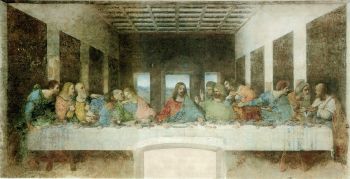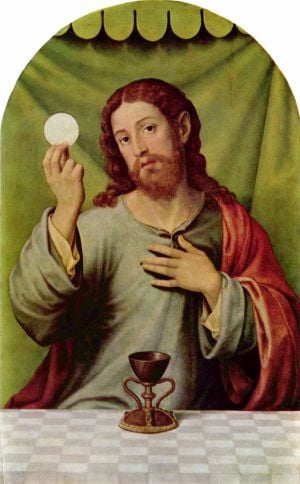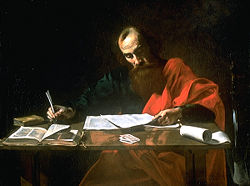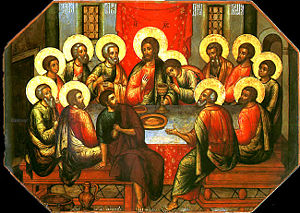The Last Supper

In the christian Gospels, the Last Supper was the last meal Jesus shared with his Twelve Apostles before his death. Described in the synoptic gospels as a Passover Seder in which Jesus predicted his betrayal and instituted the Eucharist, it has been the subject of many paintings, perhaps the most famous by Leonardo da Vinci.
While the the gospels of Matthew, Mark, and Luke are in general agreement about the events of the Last Supper, the Gospel of John presents it quite differently, omitting the institution of the Eucharist, adding the scene of Jesus washing his disciples' feet, and making the meal occur before the advent of Passover.
The Last Supper is particularly important in Christian tradition as the moment when Jesus institute the the tradition of Holy Communion. Since the Protest Reformation, various interpretations of the exact meaning of this tradition have emerged. Since the nineteenth century, critical scholarship has questioned the historicity of the Last Supper, suggesting that it largely is the product of the developing sacramental tradition of the early Christian church.
New Testament
Earliest Description
The first written description of the Last Supper is that of the Apostle Paul in Chapter 11 of his first letter to the Corinthians:
For I received from the Lord what I also passed on to you: The Lord Jesus, on the night he was betrayed, took bread, and when he had given thanks, he broke it and said, "This is my body, which is for you; do this in remembrance of me." In the same way, after supper he took the cup, saying, "This cup is the new covenant in my blood; do this, whenever you drink it, in remembrance of me." For whenever you eat this bread and drink this cup, you proclaim the Lord's death until he comes. (1 Corinthians 11:23-26)
Paul indicates he learned of the ceremony directly from the Lord, that is by revelation. The Synoptic Gospels present more details, while repeating many of the words given by Paul.
The fact that Paul claims to have learned what happened at the Last Supper through revelation leads modern scholars to speculate that the tradition of the Last Supper may be based on what Paul believed to have happened, rather than on an oral tradition passed on by eye witnesses. In this theory, the Gospel writers relied on the tradition established by Paul, which they later incorporated into their texts. Traditionally, however, the Christian churches have taught that the description of the Last Supper given in the gospels is what actually happened.
Gospel accounts
According to the synoptic gospels, Jesus had instructed a pair of unnamed disciples to go to Jerusalem to meet a man carrying a jar of water who would lead them to a house, where they were to ask for the room, specified as being the "upper room." There, they were to prepare the Passover meal.
In the course of the meal—according to Paul and the synoptic gospels, but not John—Jesus divides up some bread, says a prayer, and hands the pieces of bread to his disciples, saying "this is my body." He then takes a cup of wine, offers another prayer, and hands it around, saying "this is my blood of the everlasting covenant, which is poured for many." Finally, according to Paul and Luke, he tells the disciples "do this in memory of me." This event has been regarded by Christians of most denominations as institution of the Eucharist or Holy Communion.
The account in John differs considerably from the above description, where the meal is clearly a Passover Seder. In Luke 22:15 Jesus even says, "I have eagerly desired to eat this Passover with you." In John, however, the meal is not a Passover meal, for the Passover lambs have not yet been slaughtered in the Temple. In John 13, however, a meal takes place "just before the the Passover Feast." Here, Jesus famously washes his disciples feet. Some of the other details make it clear that this is the same event that the synoptic Gospels describe, such as Jesus' prediction of Peter's denial. However, there is no partaking of bread and wine or the institution of the Eucharist, for in John's Gospel, Jesus has indicated from the beginning of his ministry that his disciples must eat his body and eat his flesh to enter the Kingdom of Heaven.
According to the synoptic accounts, during the meal Jesus reveals that one of his Apostles would betray him. Despite the assertions of each apostle that it would not be he, Jesus reiterates his prediction and goes on to place a curse on the man, saying: "Woe to the man who betrays the Son of Man! It would be better for him if he had not been born. "Mark 14:20-21). Neither the Gospel of Mark nor the Gospel of Luke identifies the betrayer yet, but the Gospel of Matthew (26:23-26:25) and The Gospel of John (John 13:26-13:27) specify that it is Judas Iscariot
As well as the prediction of betrayal, all four canonical gospels recount that Jesus knew the apostles would "fall away." Simon Peter insists that he will not abandon Jesus even if the others do, but Jesus declares that Peter will deny Jesus three times before the cock had crowed twice. Peter insists that he will remain true even if it means death, and the other apostles are described as stating the same about themselves.
After the meal, according to John (but not mentioned at all by the synoptics), Jesus gives a large sermon to the disciples, often described as his "farewell discourse."
Luke adds a remarkable passage in which Jesus avowedly contradicts his early teaching and commands his disciples to buy weapons: "I sent you without purse, bag or sandals... now if you have a purse, take it, and also a bag; and if you don't have a sword, sell your cloak and buy one... The disciples said, "See, Lord, here are two swords." "That is enough," he replied. (Luke 22:35-38)
This concludes the description of the Last Supper. It is followed by Judas' betrayal of Jesus and the scene in the Garden of Gethsemane where Jesus commands his disciples, now armed, to kept watch while he prays. While the disciples doze, Judas is able to approach with the Temple guards, who arrest Jesus and lead him to his fate.
Remembrances
Early Christianity created a remembrance service in the form of meals known as agape feasts. These "love feasts" were apparently a full meal, with each participant bringing their own food, and with the meal eaten in a common room. The feast was held on Sundays, which became known as the Day of the Lord, to recall the resurrection. At some point in the evolving tradition, the invocation of Jesus' supposed words of over bread and wine began to be invoked. At what point the agape feasts became commemorations of the Last Supper is a matter of much discussion. Given Paul's admission that he received the words of Jesus' institution of the Eucharist as a revelation, some argue that the feast were at feast simply a communal meal, only becoming sacramental in nature gradually through Paul's influence.
In any case, the meals evolved into more formal worship services and became codified as the Mass in Catholic Church and as the Divine Liturgy in the Orthodox Churches. At these liturgies, Catholics and Eastern Orthodox celebrate the sacrament of the Eucharist, a Greek word (eucharistia) which means "thanksgiving."
Each major division of Christianity has formed a somewhat different theology about the exact meaning and purpose of events of the Last Supper. The institution of the Eucharist at the Last Supper is remembered by Roman Catholics as one of the mysteries of the Rosary, and by most Christians as the "inauguration of the New Covenant" mentioned by the prophet Jeremiah.
The historical Last Supper

As with many events in the life of Jesus, what actually happened historically at the Last Supper is not easy to discern. The synoptic gospels paint a picture which has passed vividly into the collective memory of the Christian world. However, with the advent of biblical criticism in the nineteenth century, many of the details are now questioned.
The fundamental issue has to do with the fact that the gospels were written at least a generation after the fact. They thus presume that Paul's revelation about the institution of the Eucharist was a real historical event and present it as such. Moreover, the gospels presume that Jesus' crucifixion was God's original intent in sending him as the Messiah. Thus, Jesus is presented as knowing beforehand that he would soon die, that Judas was the one who would betray him, that his disciples would all abandon him etc.
Hints found elsewhere in the New Testament, however, indicate that this may be a historical reconstruction based on later theological beliefs. For example, critics point out the disciples were greatly surprised and disillusioned by Jesus' crucifixion, which would not be the case if he prepared them for it immediately before it occurred. Luke's report that Jesus made sure the disciples were armed before posting them to watch at Gethsemane implies that perhaps their falling asleep when they were supposed to be protecting him had dire consequences, preventing him from making his escape. Finally, the fact that the Gospel of John remembers the Last Supper so differently from the synoptics shows that the communal memory of events was not clear and that different Christian communities were not in agreement over such details as what day of the week the meal was held on, whether it was as a Passover Seder or not, and whether Jesus instituted the Eucharist at this time or much earlier in his ministry.
The conclusion of most critical scholars is thus that the description of the Last Supper is larger the product of church tradition that evolved after the fact, which was then written back into the history record.
See also
- New Covenant (theology)
- Round dance of the cross
- [[wikisource:Catholic Encyclopedia (1913)/The Last Supper "|The Last Supper]".] Catholic Encyclopedia. (1913). New York: Robert Appleton Company.
ReferencesISBN links support NWE through referral fees
Brown, Raymond Edward. An Introduction to the New Testament. The Anchor Bible reference library. New York: Doubleday, 1997.ISBN 9780385247672
Brown, Raymond Edward, Joseph A. Fitzmyer, and Roland Edmund Murphy. The New Jerome Biblical Commentary. Englewood Cliffs, N.J.: Prentice-Hall, 1990.ISBN 9780138598365
Kilgallen, John J. A Brief Commentary on the Gospel of Mark. New York: Paulist Press, 1989.ISBN 9780809130597
External links
All liks retrieved November 27, 2007
- Site of "Last Supper," tourism.gov.il
- A Different Da Vinci Code The missing pieces of Leonardo's puzzle point to plain and simple Hermeticism (altreligion.about.com article).
- Was the "Last Supper" the Passover Meal?
- A zoomable 16 billion pixel image of the Last Supper
- The Last Supper interpreted by 7 Artists
- Leonardo da Vinci - The Last Supper (Zoomable Version)
- The Last Supper (Virtual Tour and super high resolution image)
- Passover observance for New Covenant Christians
- The Soteriologic Significance of the Last Supper
- Jewish Encyclopedia: Jesus: The Last Supper
- Frescos of Last Suppers in the Renaissance Refectories of Florence
Credits
New World Encyclopedia writers and editors rewrote and completed the Wikipedia article in accordance with New World Encyclopedia standards. This article abides by terms of the Creative Commons CC-by-sa 3.0 License (CC-by-sa), which may be used and disseminated with proper attribution. Credit is due under the terms of this license that can reference both the New World Encyclopedia contributors and the selfless volunteer contributors of the Wikimedia Foundation. To cite this article click here for a list of acceptable citing formats.The history of earlier contributions by wikipedians is accessible to researchers here:
The history of this article since it was imported to New World Encyclopedia:
Note: Some restrictions may apply to use of individual images which are separately licensed.



